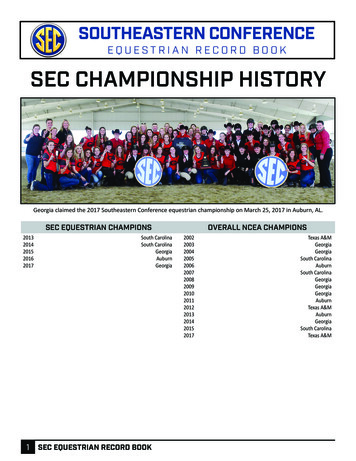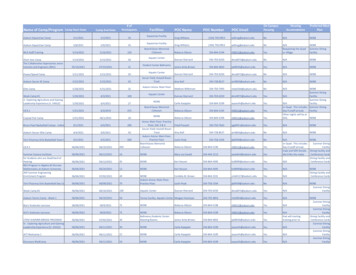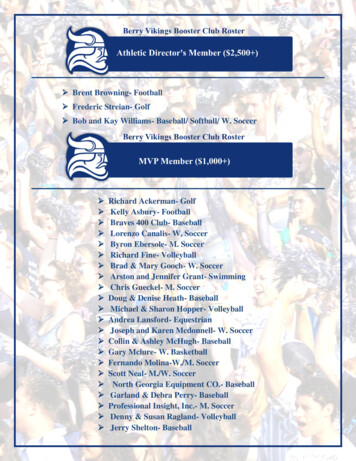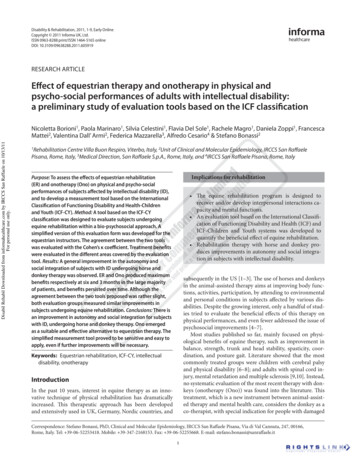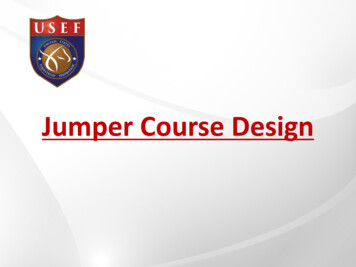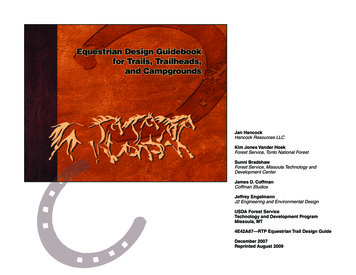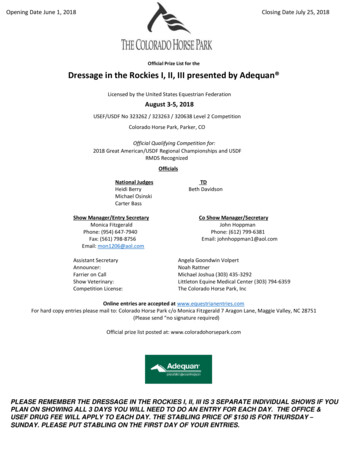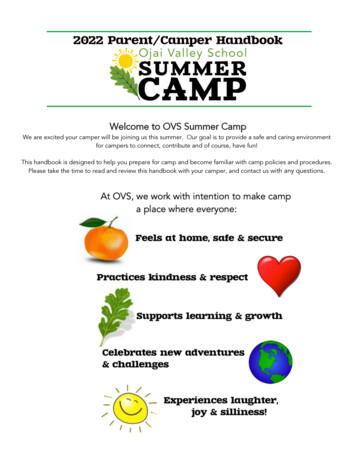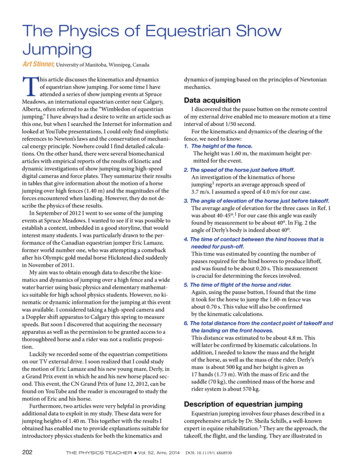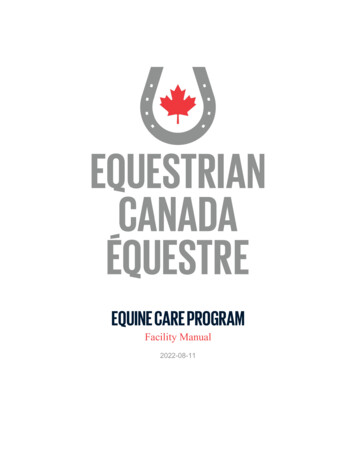
Transcription
EQUINE CARE PROGRAMFacility Manual2022-08-11
TABLE OF CONTENTSIntroduction . 3About the Equine Care Program . 3Who Can Participate? . 4About this Manual. 4Using this Manual . 4Benefits to Certification . 5Becoming Certified . 5Questions and Support . 6Equine Care Program Criteria . 7Criterion 1. VCPR. 7Criterion 2. Herd Health Plan . 8Criterion 3. Boarding Agreement. 14Criterion 4. Hoof Care . 15Criterion 5. Health and Identification Procedures. 16Criterion 6. Handling and Training . 20Criterion 7. Employee Training . 25Criterion 8. Housing. 26Criterion 9. Risk management . 29Criterion 10. Nutrition and Water . 33Criterion 11. Grooming, Blanketing, and Equipment . 35Criterion 12. Emergency Preparedness . 37Criterion 13. Transportation. 39Criterion 14. Euthanasia. 41References . 43Equine Care ProgramFacility Manualequestrian.cacanadaequestre.caPage 2 / 442022-08-11
INTRODUCTIONAbout the Equine Care ProgramTo maintain a thriving equestrian industry in Canada, it is important that we proactively take steps todemonstrate our alignment with best practices in horse welfare. Building public trust is accomplishedthrough transparency, which is what Equestrian Canada (EC) aims to achieve with the Equine CareProgram.The Equine Care Program is the first national animal care program for horses in Canada. Animal careprograms provide a level of assurance that animals are being cared for in a manner that ensures goodhealth and welfare. Animal care programs currently exist for other species in Canada, but not for horses.Therefore, EC has sought to fill this gap by creating a program that will help facilities showcase theirmanagement practices and make practical improvements where needed.The Equine Care Program certification provides a stamp of quality assurance for your clients – that youstrive to maintain the best standards of care for horses. Being certified provides your clients withconfidence that they have chosen a facility where the welfare of horses is prioritized, and your facility isdedicated to continuous improvement.The standards in the Equine Care Program are based on the minimum requirements outlined in theNational Farm Animal Care Council (NFACC) Code of Practice for the Care and Handling of Equines (or“Code of Practice”).The Code of Practice can be accessed at: https://www.nfacc.ca/pdfs/codes/equine code of practice.pdfThe goals of the Equine Care Program are to: Provide assessments to identify strengths and improvements for horse management systemsRecognize facilities that successfully demonstrate the program requirementsCreate an industry benchmark that will drive continuous improvements in horse care andmanagement in Canada, where neededThis program was developed in consultation with an expert committee consisting of veterinarians,industry members, academics, and auditors. EC also sought extensive input from our equestriancommunity through a series of focus groups and interviews with equine facility owners and veterinarians,and a national online survey of different equestrian stakeholders across Canada, including horse owners,coaches and riders, horse professionals, and more. The program is also informed by national legislationpertaining to horses in Canada.The Equine Care Program is reviewed regularly and is subject to updates based on revisions to the Codeof Practice and evolving evidence-based research.Equine Care ProgramFacility Manualequestrian.cacanadaequestre.caPage 3 / 442022-08-11
Who Can Participate?The Equine Care Program is designed for facilities that offer services such as boarding, breeding, training,raising, and maintaining the health and welfare of horses. This program is for all facilities, both new andwell established, and of all sizes. This program was created with an intimate understanding of the breadthand diversity of housing and management systems within the Canadian equine industry.Facilities can become certified if they offer one or multiple types of services. Certain programrequirements may not apply to your facility, depending on the services you offer, your facilities, and thehorses in your care.About this ManualEquestrian Canada has developed this manual as an easy-to-use, comprehensive resource to help youunderstand the requirements of this program and how to achieve them, within the context of your facilityand the services you provide.The term “horses” in this manual refers to all domestic equine species, including horses, ponies, miniaturehorses, donkeys, mules, and hinnies.Using this ManualFacilities are assessed on different criteria related to horse management and care. Each criterion in thismanual contains the following sections:Desired OutcomeIdentifies the overarching goal or outcome that the program requirements aredesigned to achieve.RationaleExplains why the program requirements are included and how it is important forhorse health or welfare.RequirementsThese are the program requirements that you must meet to become certified.TemplatesThese are templates for protocols, records, and other program documents, thatmust/may be required for this program.All templates can be found in the online Resource Library in EC’s ECampus.Guidance DocumentsThese documents are intended to help you evaluate your horses, facilities, andmanagement practices, identify areas for improvement, and help you understand andachieve the program requirements.All guidance documents can be found in the online Resource Library in EC’sECampus.Recommended PracticesProvides additional information that is not required for this program and will not beevaluated by an assessor, but may be helpful for improving your own horsemanagement and care practices. You are encouraged to implement these at yourfacility.Equine Care ProgramFacility Manualequestrian.cacanadaequestre.caPage 4 / 442022-08-11
Benefits to CertificationThere are many benefits to becoming certified: Certification demonstrates your commitment to quality horse care, which helps build trustbetween yourself and clients, staff, and your community.Gain access to tools and templates for protocols, records, forms, and other program documentsthat will help you build a robust horse management system.Promote your status as a certified facility, by using the program’s logo graphic on your website,social media platforms, and other marketing materials.Have your facility listed as an Equine Care Program certified facility on EC’s website. Yourfacility will also be featured in EC communications.Becoming CertifiedThe steps for becoming certified through the Equine Care Program include:Step 1 – Complete Training CourseComplete EC’s online ECampus course: Certification 101: An Introduction to the Equine Care Program.This course walks you through the program standards, application, and certification process, and providesyou access to the online Resource Library. This course takes only 30 minutes or less to complete.Step 2 – Submit Application and Pre-Assessment DocumentsComplete and submit the application form and pre-assessment documents in EC’s ECampus.The documents listed under Criteria 1 to 3 in this manual are referred to as the pre-assessmentdocuments. These are critical components of the program, and your facility must demonstrate that youhave met these program requirements before an assessor is scheduled to visit your facility.Step 3 – Scheduling and PaymentYou will be contacted to schedule a mutually agreeable date and time for an assessor to visit and evaluateyour facility. You will also be issued an invoice for a deposit payment. This invoice must be paid within aprescribed number of days after issuance.Step 4 – On-site AssessmentAn assessor will arrive at your facility at the scheduled date and time and conduct an on-site assessment,where they will evaluate the requirements listed under Criteria 4 to 14 in this manual.When the assessor has completed their observations, they will record their findings in an assessmentreport and review their findings with you. They will also submit the report to be evaluated for certificationreview.Step 5 – Become CertifiedYour assessment report will be reviewed, and you will be notified if your facility is recommended forcertification.Equine Care ProgramFacility Manualequestrian.cacanadaequestre.caPage 5 / 442022-08-11
If your facility is recommended for certification, you will be provided an agreement to sign. Once this iscompleted, your facility will become Equine Care Program certified.Step 6 – Maintain CertificationTo maintain your certification, you will need to follow the program assessment cycle and submit certaindocuments annually.Questions and SupportOur team is here to help. If you would like more information about the program or if you have questions,please don’t hesitate to contact us:Email: equinecare@equestrian.caEquine Care ProgramFacility Manualequestrian.cacanadaequestre.caPage 6 / 442022-08-11
EQUINE CARE PROGRAM CRITERIACriterion 1. VCPRDesired OutcomeA Veterinary-Client-Patient-Relationship (VCPR) is established annually between the facility and aveterinarian.RationaleA VCPR is established when a veterinarian becomes familiar and knowledgeable of horses at a facility,and therefore, can make appropriate clinical judgements and provide sound advice. Having a VCPR iscritical to ensuring responsible horse health care and appropriate drug use.RequirementsNumber1.0RequirementFacility has a written VCPR Validation Form.The veterinarian who signs this form is referred to as the Attending Veterinarian. Thismust be the same veterinarian who signs your Herd Health Plan Review Form (seeCriteria 2). If the facility has a working relationship with more than one veterinarian, theform only needs to be signed by the veterinarian who you consult primarily about herdhealth. It is acceptable if other veterinarians perform veterinary services for client horses.Client horses refer to any horses at the facility that are owned by other parties. Forexample, any horses that are boarded at the facility for care, training or exercise,rehabilitation, or breeding purposes are considered client horses.The form must be signed and dated by the Attending Veterinarian and the facility ownerwithin 12 months of the assessment date. The form is considered valid from the date ofsignage by the Attending Veterinarian and must be resigned annually.At minimum, the form must include: Attending Veterinarian’s first and last name, clinic or business name and address,and phone number. Attending Veterinarian’s signature and date of signage. Facility address. Facility owner’s first and last name, and phone number. Facility owner’s signature and date of signage.Equine Care ProgramFacility Manualequestrian.cacanadaequestre.caPage 7 / 442022-08-11
Statement that a VCPR is established between the Attending Veterinarian andfacility owner.Facilities can use the provided template, or the Attending Veterinarian can include theabove information on their business letterhead. The same form or letterhead can be resigned annually by a veterinarian.Templates VCPR Validation FormCriterion 2. Herd Health PlanDesired OutcomeThe facility’s herd health plan is reviewed annually by a veterinarian.RationaleA herd health plan is a preventative health program designed to maintain the health of horses. Aneffective herd health plan emphasizes prevention, rapid diagnosis, and quick decision making of any sickor injured horses at the facility.The plan should consider proactive health management, such as parasite control and vaccinations,biosecurity, and the identification and treatments of any sick or injured horses. It is important that yourplan is developed in consultation with a veterinarian to ensure your protocols are appropriate andeffective for the horses at your facility. Your protocols must be reviewed by a veterinarian annually, astheir recommendations may change each year.RequirementsNumber2.0RequirementFacility has a written Herd Health Plan Review Form.The form is signed and dated by the Attending Veterinarian and facility owner within 12months of the assessment date. The form is considered valid from the date of signage bythe Attending Veterinarian and must be re-signed annually.At minimum, the form must include:Equine Care ProgramFacility Manual Attending Veterinarian’s first and last name, clinic or business name andaddress, and phone number. Attending Veterinarian’s signature and date of signage. Facility address.equestrian.cacanadaequestre.caPage 8 / 442022-08-11
Facility owner’s first and last name, and phone number. Facility owner’s signature and date of signage. The Attending Veterinarian has reviewed the facility’s herd health plan andthe protocols are appropriate for maintaining herd health.Facilities can use the provided template, or the Attending Veterinarian can include theabove information on their business letterhead. The same form or letterhead can be resigned annually by a veterinarian.Templates Herd Health Plan Review Form2.1Facility has a written Parasite Control Protocol.The parasite control method and frequency of administration is per the recommendationsof the Attending Veterinarian, and it must prevent internal and external parasites. Multipleparasite control methods can be used (e.g., oral paste deworming, fecal egg counts).At minimum, the protocol must include: Parasite control method(s). Frequency of method(s) used.Templates Parasite Control ProtocolGuidance Documents Parasite Control Guidance2.2Facility has written Parasite Control Records.Records must reflect the method(s) and frequency indicated in the facility’s ParasiteControl Protocol (see Number 2.1).At minimum, the records must include: Horse identifier (e.g., name of horse). Date of parasite treatment or date of testing (e.g., fecal egg counts).Templates Parasite Control RecordEquine Care ProgramFacility Manualequestrian.cacanadaequestre.caPage 9 / 442022-08-11
Guidance Documents Parasite Control Guidance2.3MayapplyIf the Attending Veterinarian has advised the facility to vaccinate horses, the facility has awritten Vaccination Protocol to prevent disease.The vaccinations administered and the frequency of administration is per therecommendations of the Attending Veterinarian.At minimum, the protocol must include: Types of vaccine(s) administered. Frequency of vaccination.Horses may be exempt from vaccinations as per the advice of a veterinarian, such as thosewith a history of anaphylactic reactions or horses that do not travel off the property. Thefrequency of vaccine administration may also vary for individual horses, depending ontheir age and individual needs.Templates Vaccination ProtocolGuidance Documents Vaccination Guidance2.4MayapplyIf the Attending Veterinarian has advised the facility to vaccinate horses, the facility haswritten Vaccination Records.The records must reflect the vaccinations administered and frequency of vaccination statedin the Vaccination Protocol (see Number 2.3).At minimum, the records must include: Horse identifier (e.g., name of horse). Vaccines administered. Date of vaccine administration.Any horses exempt from vaccinations, as per a veterinarian’s recommendation, do notneed to be reflected in the records.Equine Care ProgramFacility Manualequestrian.cacanadaequestre.caPage 10 / 442022-08-11
Templates Vaccination Record2.5Facility has a written Sick and Injured Horses Protocol.Sick or injured refers to horses showing signs of illness (non-infectious or infectious),injury (including lesions), lameness, laminitis (founder), or dental problems.At minimum, the protocol must include: Horses are observed at least once per day for signs of well-being. Information about signs of lameness and laminitis (founder), dental problems,colic, and infectious diseases (e.g., respiratory infections, equine infectiousanemia), parasitism, and signs of toxicity (e.g., toxic plant consumption) in horses. Information about normal vital signs of horses. Actions taken if a horse is observed to be sick or injured. Horses must be treatedaccordingly, and veterinarian advice sought on appropriate care and treatment ifhorses do not improve, or arrangements for euthanasia are made, as needed. Medications are purchased from regulated and reputable sources, including aveterinarian or veterinary clinic, pharmacy or veterinary pharmacy, or licensedanimal medicine outlet. Medications administered to horses are used in consultation with and as per theadvice and directions of the prescribing veterinarian.If the facility has client horses, the protocol must include: Actions taken to notify a client if their horse is sick or injured. Actions taken if a client’s horse is sick or injured and the client cannot becontacted, or they refuse to provide treatment, causing the horse to be in distress.Refer to provincial legislation, as needed.Prescribing veterinarian refers to the veterinarian who originally prescribed a medication.The medication may be dispensed by the prescribing veterinarian or another reputablesource (see above). Using medications for horses in a way that differs from the directionsprovided by the prescribing veterinarian or from its licensed use without veterinaryconsultation is unacceptable. The prescribing veterinarian must be consulted for any extraor off-label use of medications.Treatment refers to items or actions intended to treat an injury, illness, or health condition.Some examples of treatment include, but are not limited to: Equine first aidEquine Care ProgramFacility Manualequestrian.cacanadaequestre.caPage 11 / 442022-08-11
Consultation with or services provided by a veterinarian or other professional (e.g.,equine nutritionist, farrier)Medications prescribed by a veterinarianTemplates Sick and Injured Horses ProtocolGuidance Documents Lameness Scoring Guidance Body Condition Scoring Guidance Injury Scoring Guidance Sick and Injured Horses GuidanceRecommended Practices Facilities should have a first aid kit available for horses. Employees should betrained and certified in equine first aid, as needed.2.6Facility has a written Infectious Disease Protocol.At minimum, the protocol must include: New arrivals are segregated from resident horses for at least seven days and theirhealth status monitored. New arrivals or horses suspected or confirmed to have an infectious disease arehoused in a designated segregation area (indoors or outdoors). The protocol mustindicate where and how horses are segregated, and at minimum, the area mustprevent nose-to-nose contact with other horses. Water and feed sources in the segregation area are cleaned between uses. Authorities are advised of horses that are suspected or confirmed to have afederally reportable disease. Refer to the Canadian Food Inspection Agency(CFIA) website for details about federally reportable diseases for horses inCanada: https://inspection.canada.caBiosecurity measures refers to practices that are used to reduce or prevent the risk ofpathogen transmission in horses.If the facility has client horses, the protocol must include: Actions taken to notify clients of a confirmed case of infectious disease at thefacility and biosecurity measures in effect (e.g., testing, quarantine, cleaningprocedures).Equine Care ProgramFacility Manualequestrian.cacanadaequestre.caPage 12 / 442022-08-11
Templates Infectious Disease ProtocolRecommended Practices Facilities should work with their Attending Veterinarian to develop a biosecurityplan to prevent and reduce the spread of infectious disease. See the CFIA NationalFarm and Facility Level Biosecurity Standard for the Equine Sector for details onhow to develop a biosecurity plan: Facility has a written Heat and Cold Stress Protocol.At minimum, the protocol must include: Information about signs of heat and cold stress in horses. Actions taken to assist horses that show signs of heat or cold stress.Assistance refers to any actions intended to address a horse that is heat or cold stressed,such as the removal or addition of blankets, bringing the horse indoors (e.g., into a barn),cold hosing or applying ice packs (for heat stress), or contacting a veterinarian, as needed.Special attention should be paid to blanketed horses, as they are at higher risk of heat stressif not monitored closely.Templates Heat and Cold Stress ProtocolGuidance Documents Heat and Cold Stress Guidance2.8MayapplyIf the facility has gestating mares or jennets, the facility has a written Foaling andNewborn Care Protocol.Jennet refers to a female donkey.If the facility has employees, the protocol must be included in the Employee TrainingProgram (see Criteria 7).At minimum, the protocol must include:Equine Care ProgramFacility Manualequestrian.cacanadaequestre.caPage 13 / 442022-08-11
Gestating mares or jennets are observed close to foaling at least twice per day forsigns of health, well-being, and foaling. Expert advice or help from veterinarian or experienced personnel is sought if anyabnormalities are observed during birth (e.g., foal is not visible after 10 minutes ofactive labour), following birth, or as needed. Newborn foals are monitored to ensure they can rise and suckle unassisted. Foals must receive colostrum. If colostrum is not available, an alternative antibodysource is readily available.Colostrum refers to the first milk produced by the mare or jennet at parturition andcontains a high level of antibodies which protect newborn foals from infection until theirown immune system has developed.Templates Foaling and Newborn Care ProtocolGuidance Documents Foaling and Newborn Care GuidanceCriterion 3. Boarding AgreementThis section only applies to facilities that have client horses.Desired OutcomeThere is a boarding agreement that includes the facility’s protocols related to horse management and care.RationaleIt is important that facility owners and their clients have a mutual understanding of the facility’sprotocols. Misunderstandings can cause discrepancies in horse management, which poses a risk to horses.For example, if clients do not follow the facility’s parasite control protocol, this can expose other horsesto higher loads of parasites and parasite-related disease. Having a boarding agreement with detailedinformation reduces risks, stress, interpersonal conflicts, and ensures consistent horse managementpractices for optimal herd health.RequirementsNumber3.0RequirementFacility has a written Boarding Agreement that is provided to and signed by all clients.At minimum, the agreement must include:Equine Care ProgramFacility Manualequestrian.cacanadaequestre.caPage 14 / 442022-08-11
Parasite Control Protocol (see Criteria 2) Sick and Injured Horses Protocol (see Criteria 2) Infectious Disease Protocol (see Criteria 2) Heat and Cold Stress Protocol (see Criteria 2) Hoof Care Protocol (see Criteria 4) Humane Handling and Training Ethics Agreement (see Criteria 6)And the following, if applicable: Vaccination Protocol (see Criteria 2). Newborn and Foaling Care Protocol (see Criteria 2). Blanketing Protocol (see Criteria 11).These documents can be included as an appendix in the boarding agreement.Templates Boarding Agreement ExampleCriterion 4. Hoof CareDesired OutcomeHorse’s hooves are trimmed to maintain hoof functionality and prevent overgrowth or abnormalities thatmay cause injury or discomfort.RationaleRegular hoof care is essential for overall horse health and longevity through hoof and leg soundness1. Allhorses need regular hoof trimming and care to ensure proper hoof health.Requirements:Number4.0RequirementFacility has a written Farrier Schedule.The facility can have multiple schedules and farriers. Hooves must be trimmed frequentlyenough to ensure functional condition and prevent overgrowth or abnormalities (e.g., hoofcracks) that may cause a horse to be in pain or discomfort.At minimum, the schedule must include:Equine Care ProgramFacility Manualequestrian.cacanadaequestre.caPage 15 / 442022-08-11
Horse identifier (e.g., name of horse). All horses at the facility are reflected in theschedule, including client horses (if applicable). Farrier first and last name, or company name. Scheduled trimming date(s).Templates Farrier ScheduleGuidance Documents Hoof Care GuidanceRecommended Practices Horses’ hooves are trimmed every 5-8 weeks, which may depend on factors suchas the horse’s age, activity level, nutrition, and breed.4.1MayapplyIf the facility has client horses, the facility has a written Hoof Care Protocol, and it isincluded in the Boarding Agreement (see Criteria 3).At minimum, the protocol must include: Clients are responsible for ensuring their horse’s hooves are trimmed andmaintained to prevent hoof overgrowth and abnormalities that may cause injury ordiscomfort to horses. Actions taken to address a client’s horse with hoof overgrowth or abnormalities, ifthe client cannot be contacted or refuses to provide proper hoof trimming and care,causing the horse to be in distress. Refer to your provincial legislation.Criterion 5. Health and Identification ProceduresDesired OutcomeHealth and identification procedures are performed with minimal stress and pain. All dental and surgicalprocedures, including castration, are performed by a veterinarian or a competent individual under directveterinary supervision.RationaleCastration and Dental CareThe Canadian Veterinary Medical Association (CVMA) regards castration as a medical procedure whichshould be performed by a veterinarian using appropriate surgical, anesthetic, and analgesic techniques.However, in Canada, castration by non-veterinarians (or “operator”) may be exempt from certainVeterinary Acts.Equine Care ProgramFacility Manualequestrian.cacanadaequestre.caPage 16 / 442022-08-11
Dental care involves specialized knowledge and skills to perform a comprehensive oral exam, diagnoseoral disease, and address health conditions that may arise during oral examinations and procedures and toprescribe follow-up care. Dental procedures may also require sedatives to ensure the comfort of horsesand safe evaluation or treatment of the oral cavity.If the facility uses an operator for castration or dental procedures, they must demonstrate that the operatorhas a VCPR with a veterinarian.IdentificationThere are different types of identification used for horses, including microchipping, tattooing, hot-ironand freeze branding, and iris scans. Identification provides proof of ownership and allows for thetraceability of horses. Hot iron branding is painful to horses, as it causes swelling and skin sensitivity.Freeze branding may be less painful than hot iron branding. There is limited research on microchippingand lip tattooing, though the effects of microchipping are shorter lasting than hot-iron or freeze branding.Hot-iron branding is discouraged, especially if other identification can be used. Pain control optionsshould be discussed with a veterinarian when performing identification procedures.Tail DockingTail docking for cosmetic reasons is prohibited. The CVMA vi
Equine Care Program Facility Manual equestrian.ca canadaequestre.ca Page 2 / 44 2022-08-11 TABLE OF CONTENTS Introduction
